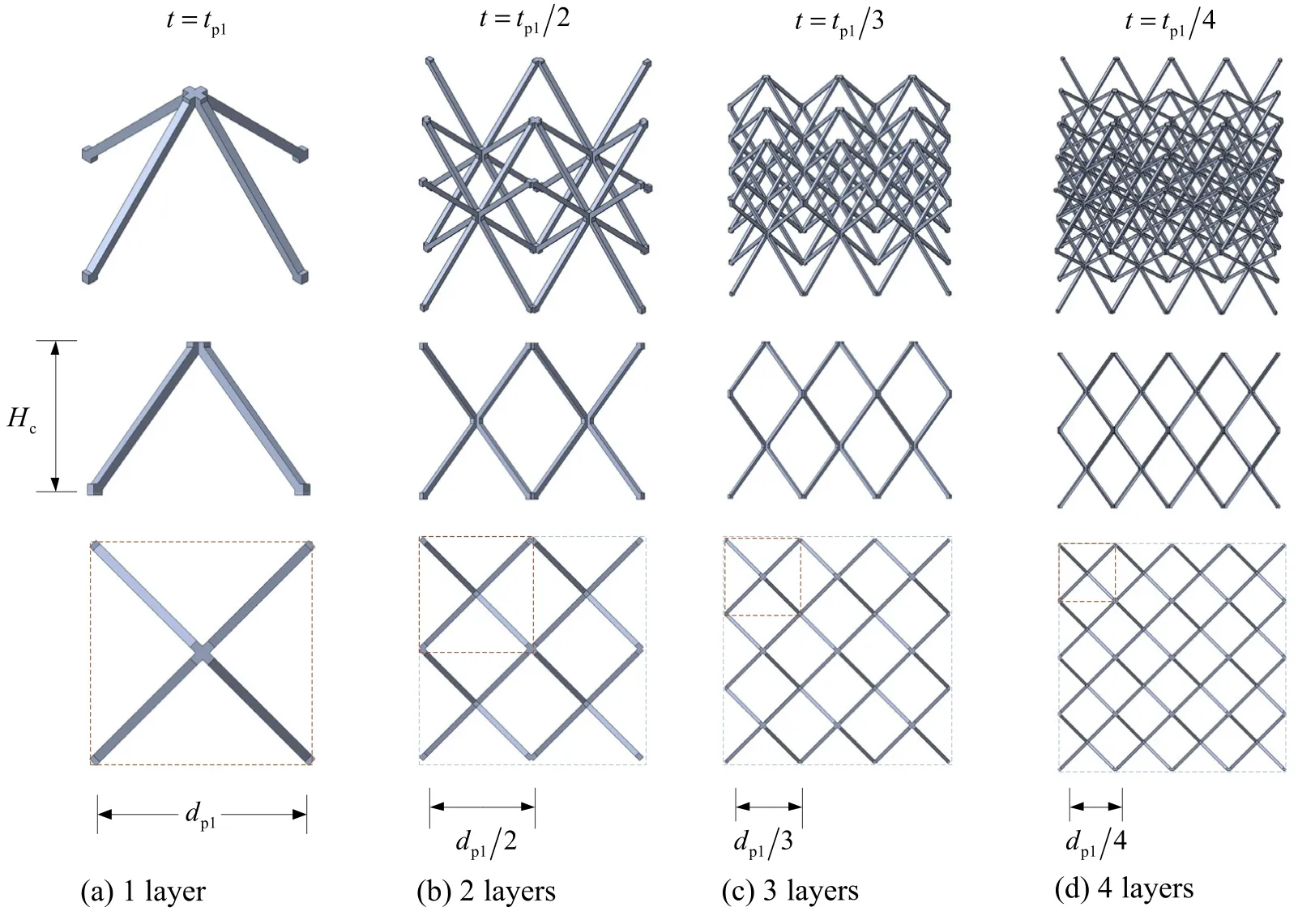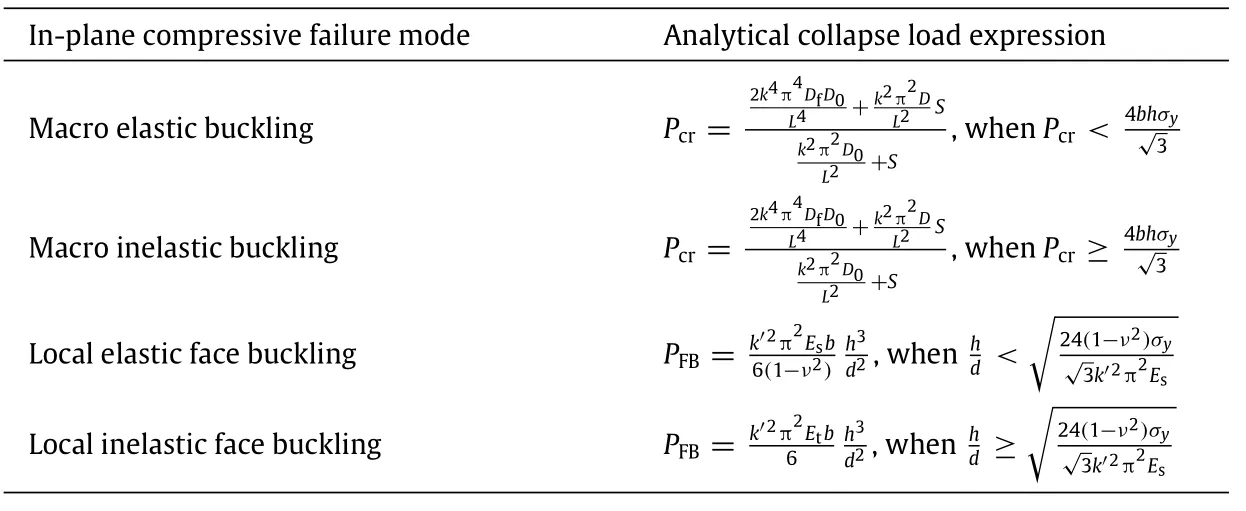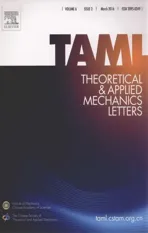The optimum layer number of multi-layer pyramidal core sandwich columns under in-plane compression
2016-11-14LiJiaFengLinZhiWuGuoCaiYu
Li-Jia Feng,Lin-Zhi Wu∗,Guo-Cai Yu
Center for Composite Materials,Harbin Institute of Technology,Harbin 150001,China
Letter
The optimum layer number of multi-layer pyramidal core sandwich columns under in-plane compression
Li-Jia Feng,Lin-Zhi Wu∗,Guo-Cai Yu
Center for Composite Materials,Harbin Institute of Technology,Harbin 150001,China
H i G H L i G H T s
•The effect of layer number on the in-plane compressive property of columns is investigated.
•The analytical calculations agree well with the simulations.
•One facesheet-thickness to core-height ratio corresponds to one optimum layer number.
A R T i C L Ei N F O
Article history:
8 January 2016
Accepted 12 January 2016
Available online 20 February 2016
Multi-layer pyramidal core
Sandwich columns
In-plane compressive property
Optimum layer number
The effect of the face thickness to core height ratio on different multi-layer pyramidal core sandwich columns under in-plane compression is investigated theoretically and numerically.Numerical simulation is in good agreement with theory.Results indicate that one specified face thickness to core height ratio corresponds to one optimum layer number of multi-layer pyramidal core sandwich columns in consideration of engineering application.This result can guide the sandwich structure design.
©2016 The Authors.Published by Elsevier Ltd on behalf of The Chinese Society of Theoretical and Applied Mechanics.This is an open access article under the CC BY-NC-ND license(http:// creativecommons.org/licenses/by-nc-nd/4.0/).
All-metallic sandwich panels consisting of low density cores and thin facesheets have impending application as ultra-light load bearing panels in aerospace and other fields.Several open cell topologies have been proposed based on truss lattices with pyramidal[1],tetrahedral[2],3D-Kagome[3],and other topologies[4]. Usually,sandwich panels are loaded by various modes of loading(in-plane compression,out-of-plane compression,bending,shear,etc.)[5-8],andtheirstrengthsdependuponthecompressive strength of the core and the cell size(which controls the face sheet deformation periodicity)[9].Thus,while pyramidal and tetrahedraltopologysystemsusuallyoffersignificantlysuperiorstructural performance,improvements appear feasible,based on the following limitation in relation to unit cell size:the thicker core leads to larger intervals between the point rows where the lattice truss core contacts the face sheets,and this weakens the resistance to local buckling of the face sheets[10].
In order to address the limitation,Cote et al.[6]proposed a multi-layer pyramidal core sandwich column.The peak in-plane compressive load increases accordantly with the layer number when the face sheet is thin.The reason is that the increasing of layernumbermightincreasetheresistancetowrinklingoftheface sheet.
In this paper,the in-plane compressive properties of the multi-layer pyramidal core sandwich columns are investigated theoretically and numerically.The effects of the face thickness to coreheightratioandthenumberlayeronthein-planecompressive propertiesareanalyzed.Andthenumericalsimulationiscompared with the theory analysis.
The multi-layerpyramidal coresandwich structure is,alongthe in-plane direction of core,the lattice is periodic pyramids,and along the thickness direction of core,the lattice is a stack of the single layer pyramids facing each other,as seen in Fig.1.Since the multi-layerpyramidallatticesareconstructedfromthesinglelayer pyramidal unit cell,they have the same relative density.Consider the 3D single layer pyramidal unit cell indicated in Fig.2(b). Geometricalparametersofthepyramidaltrusslatticearesketched. Note that for the square cross section truss,t=w,and its length is equal to l.In the present paper take the angleω=45°. By calculating the volume of regions occupied by materials,and scaling this by the unit cell volume,the relative density,,ofpyramidal unit cell is given bywheretheinter-nodespacingdisequaltothewidthoftheunitcell. Thepredictedrelativedensityiscalculatedinthelimitofvanishing node size.

Fig.1.Four layer numbers of multi-layer pyramidal core sandwich columns with the same relative densityand core height Hc.

Fig.2.(a)Sandwich columns subjected to in-plane compression.(b)Unit cell of single layer pyramidal core.

In order to compare the properties of different layer number sandwich columns,the values of both relative densityand core height Hcneed to be fixed.In this case,for the multi-layer pyramidalsandwichcolumn,thereisaone-to-onecorrespondence among the side length of the strut t,the inter-node spacing d,and the number of the pyramidal layer numbers N,which can be seen by Eq.(1)and Fig.2(b).
Uniaxial compression test of 304 stainless steel samples that have underwent the same thermal cycle used for fabrication of the brazed sandwich structures are performed and used to determine parent alloy properties and the tangent modulus,Et,for the face sheet under in-plane compression.Three compression-repeated tests are performed according to ASTM E8-01.The compressive stress-strain response and its fitted curve by modified Ramberg-Osgood model[11]are shown in Fig.3.The 304L stainless steel alloy had a 0.2%offset yield strengthσy=212 MPa and Es= 213 GPa.The elastic Poisson’s ratio for steelν=0.3.Also,the tangent modulus Et(given by the slope of the true stress-truestrain response of the solid material at the inelastic bifurcation stressσc)is obtained by differentiation of the fitted curve.The inelastic bifurcation stress is obtained using the tangent modulus theory[12,13].

Table 1 Analytical expressions for the in-plane compression collapse loads of multi-layer pyramidal core sandwich columns.

Fig.3.The compressive true stress-true strain curve of the 304 stainless steel after exposuretothethermalcycleusedforbrazing.ModifiedRamberg-Osgoodfittothe compressive stress-strain response is also shown.
Consider a sandwich column of length L and width b with clamped ends and subjected to in-plane compressive load P,as sketched in Fig.2(a).The sandwich column comprises of face sheets of thickness Hcand multi-layer pyramidal cores with one layer to four layer pyramidal cores as seen in Fig.1.They have the same relative densityand heightmm.Since the in-plane compressive response of a multi-layer pyramidal core sandwich column is anisotropic,the response is dependent on the direction of compression.We define the direction of in-plane compression via the angleαwith the x1axis as shown in Fig.2(b). Here,the in-plane displacements are applied in the direction:α= 45°.At least four failure modes exist for a multi-layer pyramidal core sandwich column under in-plane compressive loading:(i)macro elastic buckling,(ii)macro inelastic buckling,(iii)local elastic face buckling,and(iv)local inelastic face buckling[6].
For the multi-layer pyramidal core sandwich column,approximate analytical expressions for the in-plane compressive collapse load P can be given in Ref.[6]and are summarized by the expressions listed in Table 1.
The in-plane compressive collapse loads do not depend upon the core topology but depend upon the inter-node spacing d under the face buckling failure mode.Therefore,the analytical expressions in Table 1 can characterize the in-plane compressive collapse loads of all the multi-layer pyramidal core sandwich columns.However,since the inter-node spacing d of the multilayer pyramidal core sandwich columns with different layer numbers differs obviously,the results predicted by the analytical expressions in Table 1 are also different.Note that the inter-node spacing of the multi-layer pyramidal core sandwich columns with 1 to 4 layers are dp2=dp1/2,dp3=dp1/3,and dp4=dp1/4,respectively,as seen from Fig.1.In these sandwich columns,we set k′=1 for the face sheet buckling as pin-jointed struts.For the multi-layer pyramidal truss core with odd layer number N,we obtain the shear rigidity S as[6,14]

Weshowthedominanceregimesofthefailuremodesdescribed aboveinacollapsemechanismmap.Thecollapsemodeisassumed to be the one associated with the lowest collapse load P in constructing such a map.These maps are developed as a function of non-dimensional parameters h/Hcand L/Hc.We evaluate the minimum normalized collapse load)at given values of h/Hcand L/Hcand then obtain the boundary of each failure mode.Figure 4 shows the failure mechanism maps for the four layernumbercoresinFig.1madeof304stainlesssteel,tocompare their in-plane compressive collapse loads.Each map comprises of four boundary lines which intersect at one point,and these lines divide each map into four regimes,dominated by the four failure modes described above,respectively.Note that the boundary lines between the macro elastic buckling mode and macro inelastic buckling mode are the same for these four maps.The regimes where the four core panels possess the same failure modes are pointed out in Fig.4,i.e.regimes of A,B,C,and D,and the four regimes correspond to the local elastic face buckling mode,the localinelasticfacebucklingmode,themacroelasticbucklingmode and the macro inelastic buckling mode,respectively.Note that the in-plane compressive collapse modes of the multi-layer pyramidal core sandwich columns with four different layer numbers are all elastic or inelastic face buckling in the shadow region as indicated in Fig.4.It dictates that for the multi-layer pyramidal column with more layer number,it is more difficult for the local face buckling mode to occur.Moreover,it is noted that simulated geometries to validate the theoretical analysis are selected in an attempt to exhibit the face sheet buckling failure modes,and marked in the mechanism map.
To check the validity of the theoretical analysis,the in-plane compressive responses of a single layer and a two-layer pyramidal core sandwich columns are simulated.Three geometries are selected:h=0.55,h=0.7,and h=0.9 with the same core height Hc=40 mm and relative densityThe in-plane compressive behaviors of the lattice truss column are simulated by finite element method depending on the business software ABAQUS/Explicit.The truss panel consists of the 304 stainless steelpyramid lattice core and facesheets.The 304 stainless steel are created using eight-node 3D reduced elements(C3D8R),with the following mater-ial properties:E=212 GPa,ν=0.33,and ρ=7800kg·m3.Themodel‘Tie’isusedforconnectingbetween facesheets and core.The clamp is established in the model,which is modeled as a rigid body using a rigid constraint and its motion is governed by the rigid reference point.All the nodes of the bottom clamp are fixed.

Fig.4.Collapse mechanism maps of the multi-layer pyramidal core sandwich columns with one to four layers of relative densityThe geometries simulated here are indicated on the map.
The relative in-plane compressive face buckling loads= PFB/(bHcσy)of columns are functions of the ratio h/Hcwith a given inter-node spacing d as seen in Table 1.The predicted relative inplane compressive face buckling loadsare plotted against the ratio h/Hcof the multi-layer pyramidal core sandwich columns with four layer numbers in Fig.5.Note that the relations in Fig.5 are applicable for the column sizes in the shadow region of Fig.4,where the collapse modes of all the four multi-layer pyramidal core sandwich columns are face sheet buckling(elastic or inelastic).The comparison between the analytical predictions and simulations of the relative in-plane compressive face buckling loads are shown in Fig.5.Good agreement is observed,which solidifies the validity of the theoretical analysis.Examination of Fig.5 shows that the transition ratios h/Hcfrom facesheet elastic to inelastic buckling of the multi-layer pyramidal core sandwich columns with pyramidal layers from 1 to 4 are~0.050,~0.025,~0.017,~0.013,and 0.010,respectively,which is consistent with Fig.4.Since the facesheet alloy exhibits low strain hardening and facesheet inelastic bifurcation stressσc≈σy,the relative in-plane compressive loads of the multi-layer pyramidal core sandwich columns with different layer numbers begin to converge after face sheets collapse by inelastic buckling.Comparison of the results indicates the effect of layer number on the properties of the multilayerpyramidalcoresandwichcolumns:theincreasingofthelayer number increases the in-plane compressive load of the multi-layer pyramidal core sandwich columns.Nevertheless,the increasing of the layer number will result in more difficulty in fabrication. Therefore,if the mechanical property is similar,the multi-layer pyramidal core sandwich column with the smallest layer number is optimal in engineering application.In this sense,when the ratio h/Hclies in the scales of 0.013<h/Hc<0.017,0.017<h/Hc<0.025,and 0.025<h/Hc<0.050,the optimum structure corresponds to the multi-layer pyramidal core sandwich columns with 4 layers,3 layers,2 layers,and 1 layer,respectively.Based on the above,we can draw a conclusion that there is a one-to-one correspondence between the face thickness to core height ratiorange and the optimum layer number of the multi-layer pyramidal core sandwich columns.This conclusion can guide the structure design in engineering application.

Fig.5.Simulations and predictions of the relative in-plane compressive facesheet buckling loads(normalized byσybHc)plotted against h/Hcof the multi-layer pyramidal core sandwich columns with four different scales.The triangular symbol and the square symbol represent‘simulation of single layer pyramid’and‘simulation of two layer pyramid’,respectively.
The effect of layer number on the in-plane compressive property of multi-layer pyramidal core sandwich columns is investigated theoretically and numerically.The analytical calculations agree well with the simulations.Results indicate that the increasing of the layer number increases the in-plane compressive load of the multi-layer pyramidal core sandwich columns.What’s more,there is a one-to-one correspondence between the face thickness to core height ratio range and the optimum layer number of the multi-layer pyramidal core sandwich columns.
Acknowledgment
The present work was supported by the National Natural Science Foundation of China under Grant No.11432004.
[1]F.W.Zok,S.A.Waltner,Z.Wei,etal.,Aprotocolforcharacterizingthestructural performance of metallic sandwich panels:application to pyramidal truss cores,Int.J.Solids Struct.41(2004)6249-6271.
[2]H.J.Rathbun,Z.Wei,M.Y.He,et al.,Measurement and simulation of the performance of a lightweight metallic sandwich structure with a tetrahedral truss core,J.Appl.Mech.Trans.ASME 71(2004)368-374.
[3]J.Wang,A.G.Evans,K.Dharmasena,et al.,On the performance of truss panels with Kagomé cores,Int.J.Solids Struct.40(2003)6981-6988.
[4]D.T.Queheillalt,H.N.G.Wadley,Cellular metal lattices with hollow trusses,Acta Mater.53(2005)303-313.
[5]S.Chiras,D.R.Mumm,A.G.Evans,et al.,The structural performance of nearoptimized truss core panels,Int.J.Solids Struct.39(2002)4093-4115.
[6]F.Cote,R.Biagi,H.Bart-Smith,et al.,Structural response of pyramidal core sandwich columns,Int.J.Solids Struct.44(2007)3533-3556.
[7]V.S.Deshpande,N.A.Fleck,Collapse of truss core sandwich beams in 3-point bending,Int.J.Solids Struct.38(2001)6275-6305.
[8]I.Sridhar,N.A.Fleck,End compression of sandwich columns,Compos.Part A Appl.Sci.Manuf.33(2002)353-359.
[9]F.K.Zok,H.J.Rathbun,Z.Wei,et al.,Design of metallic textile core sandwich panels,Int.J.Solids Struct.40(2003)5707-5722.
[10]N.Wicks,J.W.Hutchinson,Optimal truss plates,Int.J.Solids Struct.38(2001)5165-5183.
[11]K.J.R.Rasmussen,Full-range stress-strain curves for stainless steel alloys,J.Constr.Steel Res.59(2003)47-61.
[12]S.P.Timoshenko,J.M.Gere,Theory of Elastic Stability,McGraw-Hill International Book Company,New York,1985.
[13]F.R.Shanley,Mechanics of Materials,McGraw-Hill,New York,1967.
[14]M.Zupan,V.S.Deshpande,N.A.Fleck,The out-of-plane compressive behavior of woven-core sandwich plates,Eur.J.Mech.A 23(2004)411-421.
1 October 2015
.Tel.:+86 451 86402549;fax:+86 451 86402386.
E-mail address:wlz@hit.edu.cn(L.-Z.Wu).
http://dx.doi.org/10.1016/j.taml.2016.01.002
2095-0349/©2016 The Authors.Published by Elsevier Ltd on behalf of The Chinese Society of Theoretical and Applied Mechanics.This is an open access article under the CC BY-NC-ND license(http://creativecommons.org/licenses/by-nc-nd/4.0/).
in revised form
*This article belongs to the Solid Mechanics
杂志排行
Theoretical & Applied Mechanics Letters的其它文章
- Analytical design of effective thermal conductivity for fluid-saturated prismatic cellular metal honeycombs
- Effect of temperature on the compressive behavior of carbon fiber composite pyramidal truss cores sandwich panels with reinforced frames
- Elastic properties of chiral,anti-chiral,and hierarchical honeycombs: A simple energy-based approach
- The effect of Görtler instability on hypersonic boundary layer transition
- Stability analysis of liquid filled spacecraft system with flexible attachment by using the energy-Casimir method
- Cicada(Tibicen linnei)steers by force vectoring
